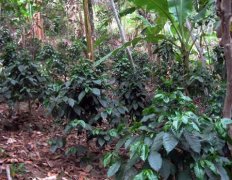Fine Coffee learn how to get male and female Coffee
Chickens can be divided into cocks and hens, but are there any differences between male and female eggs?
Recently, the theory of public beans and mother beans has become quite popular. A friend who has just returned from Bali, Indonesia, and the bar manager of a five-star hotel both talked about it with me. The former said that when she went to Bali, the locals recommended public beans to her and did a cup test on the spot. The taste of male beans is obviously better than mother beans, while the latter boasts to me that all the beans supplied by their suppliers are public beans, and there are no mother beans. Where does the idea of good coffee beans come from? The theory of male and female coffee beans originated in Indonesia, spread in Taiwan, and ended up in the mainland, and its influence is mainly concentrated in the above three places, so locals in Bali will use public beans as a selling point to sell coffee.
The so-called male bean refers to the special fruit of only one coffee bean in a coffee fruit, because its shape is generally shuttle-shaped, in order to be different from ordinary flat coffee beans, it is called Peaberry, that is, the so-called male beans, and other normal beans are called mother beans. From a botanical point of view, hermaphroditic coffee has no distinction between male and female, so the theory of male and female is only a term coined by businessmen.
The proportion of male beans in coffee beans is generally 5%-8%. According to statistics, most male beans grow on the outside of the crown where they are easily disturbed by external factors, so there is also a saying that male beans are in fact the product of some kind of external force.
In terms of taste, public beans do have richer fat, more mellow taste and more mellow aftertaste, which is the reason why people will go after them. But at present, scientists have no evidence that male beans have more soluble aromatic substances than female beans, but they are just rich in oil, which is also due to the fact that one bean accounts for the nutrients of two female beans.
Important Notice :
前街咖啡 FrontStreet Coffee has moved to new addredd:
FrontStreet Coffee Address: 315,Donghua East Road,GuangZhou
Tel:020 38364473
- Prev

The grading system of giving priority to defects in the size of Blue Mountain Coffee
Although the output of Blue Mountain Coffee is very small, it has a strict grading system, even if it is produced in the legal Blue Mountain area, it should be graded according to the size of beans and the proportion of defects. Blue Mountain No.1 Blue Mountain No. 1 bean type: 96% above 17 Blue 18 eyes defective bean proportion: 2% Blue Mountain No.2 Blue Mountain 2 bean type: 96% above 16 inch defective bean proportion: 2% Blue
- Next

The production of high-quality coffee beans
Coffee trees take 3-5 years from planting to fruiting. 6-10 years of coffee trees are the most likely to bear fruit, about 15-20 years, is the harvest period. Coffee trees are usually bred in nurseries and grow into saplings, and then moved to coffee farms a year later, in full compliance with the way the Arabs planted and cultivated coffee trees. Coffee trees will continue to take root downward and upward in the first four or five years of their growth.
Related
- Beginners will see the "Coffee pull flower" guide!
- What is the difference between ice blog purified milk and ordinary milk coffee?
- Why is the Philippines the largest producer of crops in Liberia?
- For coffee extraction, should the fine powder be retained?
- How does extracted espresso fill pressed powder? How much strength does it take to press the powder?
- How to make jasmine cold extract coffee? Is the jasmine + latte good?
- Will this little toy really make the coffee taste better? How does Lily Drip affect coffee extraction?
- Will the action of slapping the filter cup also affect coffee extraction?
- What's the difference between powder-to-water ratio and powder-to-liquid ratio?
- What is the Ethiopian local species? What does it have to do with Heirloom native species?

